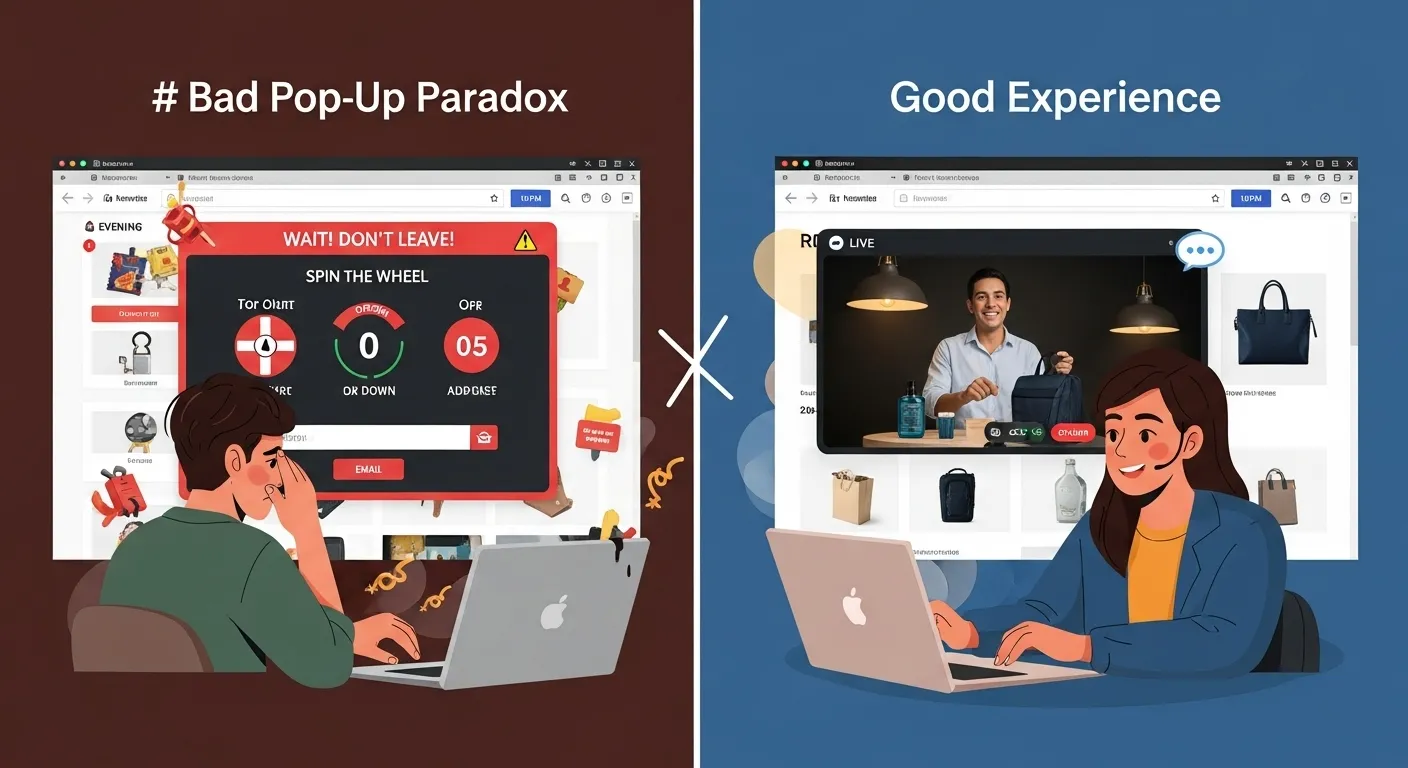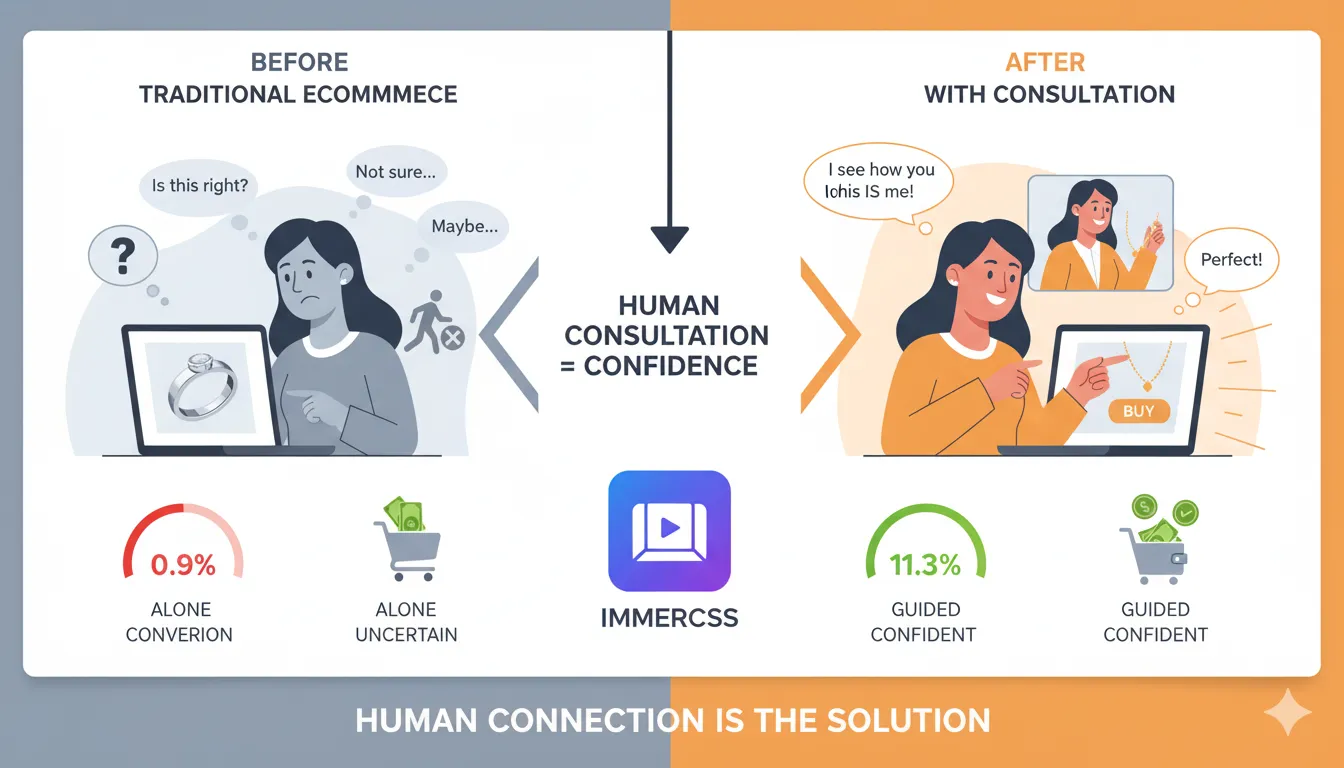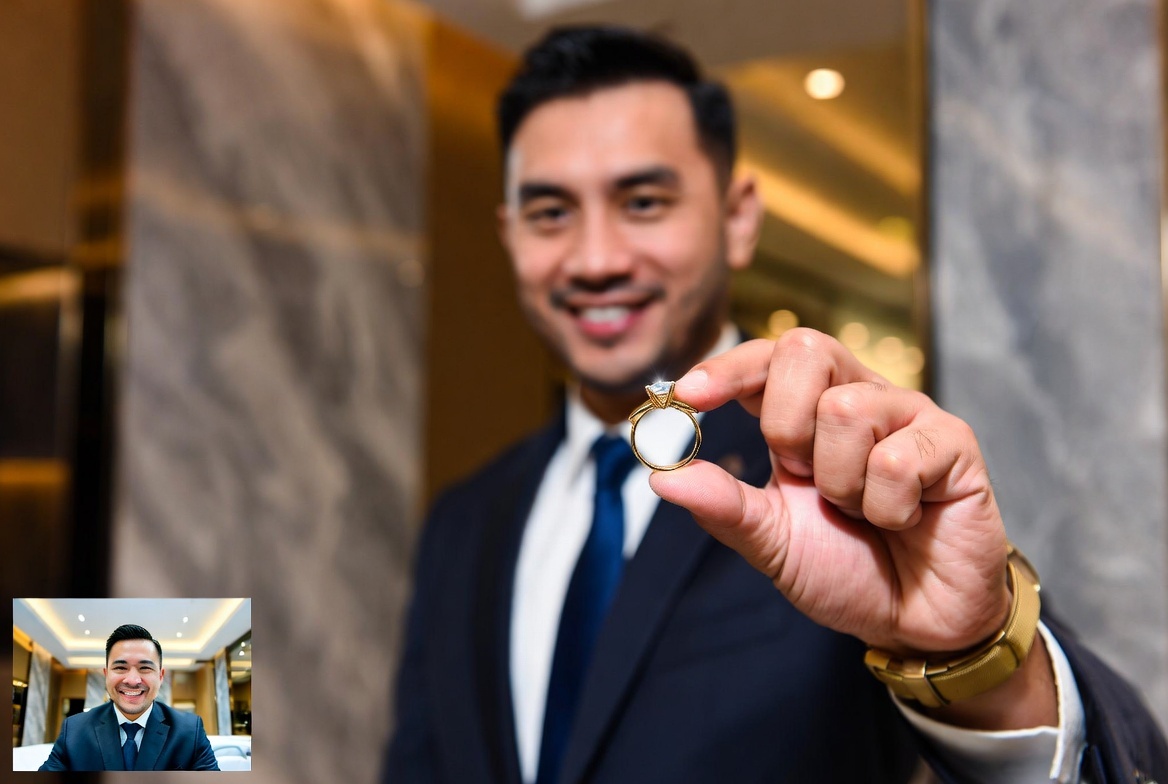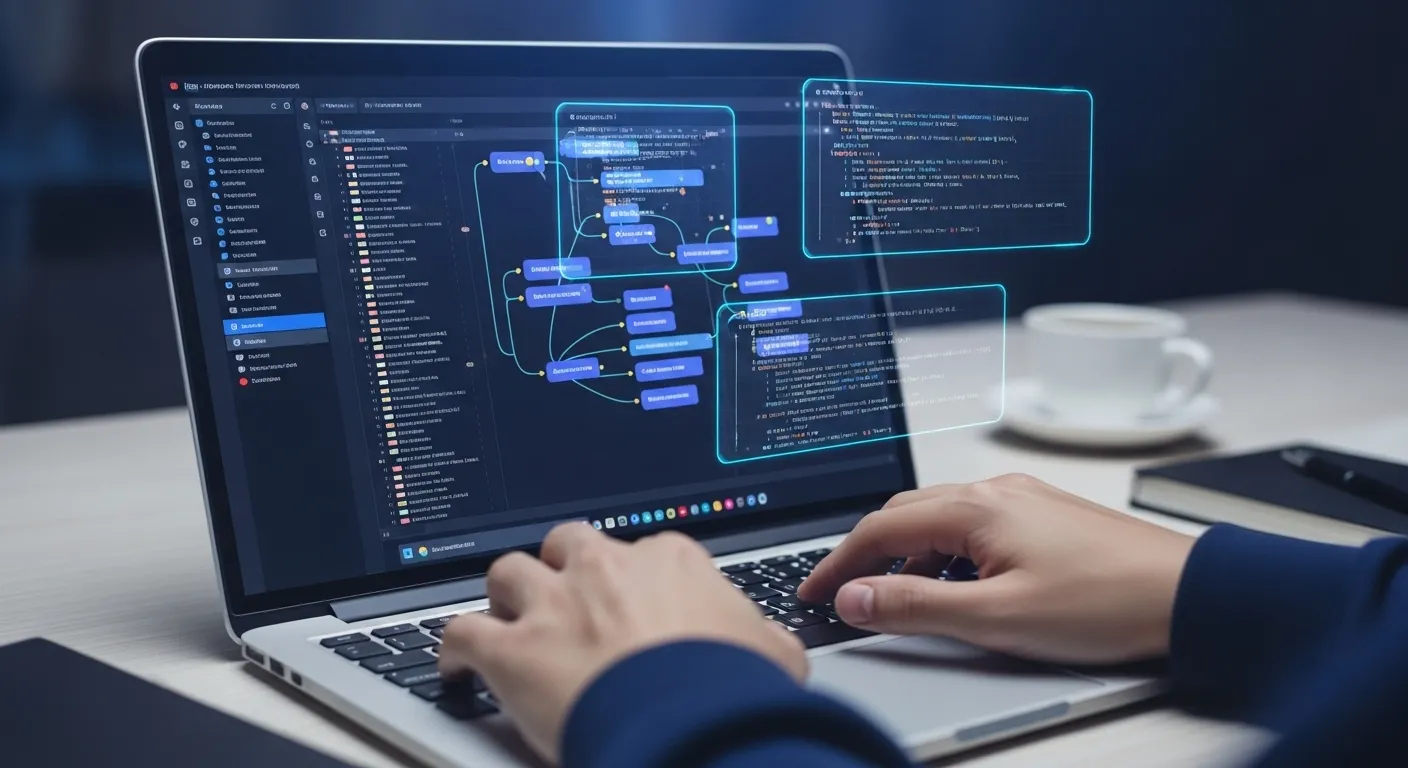The Email Pop-Up Paradox: Why You Hate Them, Why Everyone Uses Them, and What Actually Works Better
There’s a Reddit post that perfectly captures one of ecommerce’s most uncomfortable truths.
An online store owner writes: “I find email harvesting annoying… I won’t even shop on some sites because of constant discount pop-ups or spin-the-wheel reminders. So I don’t use them on my site. But I also know this probably defies the online marketing playbook.”
The comments reveal a fascinating split: half agree passionately (“those pop-ups are conversion killers!”), while the other half insists they’re necessary evils (“but they work, the data proves it!”).
Here’s why both sides are right—and wrong—and what this tension reveals about the fundamental problem with modern ecommerce.
Why we all hate pop-ups (but keep using them anyway)
Let’s start with the uncomfortable data that keeps those pop-ups alive:
Pop-up performance metrics:
- Average conversion rate: 3.09% (Sumo data across 1.8 billion pop-ups)
- Well-optimized pop-ups: 5-15% conversion
- Exit-intent pop-ups specifically: 2-4% conversion
- Mobile pop-ups: 4.5% average (higher than desktop’s 3.8%)
For a site with 100,000 monthly visitors, a 5% pop-up conversion means 5,000 new email subscribers. At $1-2 revenue per subscriber per month, that’s $5,000-10,000 monthly revenue directly attributable to the annoying pop-up.
That’s why they persist despite everyone hating them.
But here’s what the “pop-ups work” crowd conveniently ignores:
The hidden costs:
- Immediate 2-4% bounce rate increase when pop-ups appear within first 3 seconds
- 73% of visitors report negative feelings toward brands using aggressive pop-ups
- 70% of mobile users abandon sites with intrusive interstitials
- Google penalties for mobile sites with intrusive interstitials (since January 2017)
- Brand perception damage that’s impossible to quantify but very real
The math becomes less clear when you factor in visitors who abandon before ever seeing your products because they’re immediately assaulted with “WAIT! Before you go…”
The real problem isn’t the pop-up—it’s what it represents
That Reddit poster’s instinct is correct, but for reasons deeper than just “pop-ups are annoying.”
The pop-up is a symptom of a fundamental ecommerce problem: the one-shot conversion model.
Traditional ecommerce operates on the assumption that:
- Visitor lands on site (probably via paid ad)
- You have 8-15 seconds to capture attention
- If they leave without buying, they’re gone forever
- Therefore, you MUST capture email before they disappear
- Then you’ll spend months nurturing that email hoping they eventually buy
This creates the desperate “last chance to connect” mentality that produces aggressive pop-ups, exit-intent offers, spin-the-wheel games, countdown timers, and all the manipulative tactics that make online shopping feel like running a gauntlet.
The pop-up isn’t the problem. The problem is building a business model that requires interrupting customers with desperate last-ditch efforts to maintain any future connection.
Why “just don’t use them” isn’t a viable strategy either
The Reddit poster is stuck in a genuine dilemma:
Option A: Use aggressive pop-ups
- Capture 5% of visitors as email subscribers
- Annoy 73% of visitors
- Damage brand perception
- Potentially increase bounce rates
- Feel gross about tactics
Option B: Don’t use pop-ups
- Maintain brand integrity
- Create better user experience
- Capture maybe 0.5% who voluntarily sign up via footer form
- Lose connection with 99.5% of visitors who leave
- Watch competitors with pop-ups capture those customers via email nurture campaigns
Neither option is actually good. You’re choosing between “effective but gross” and “principled but ineffective.”
This is a false choice created by outdated assumptions about how ecommerce customer relationships work.
What if the entire framing is wrong?
Here’s the question nobody asks when debating pop-ups:
Why are we so desperate to capture emails in the first place?
The standard answer: “Because if they leave without buying, email is our only way to bring them back.”
But why is that true? Why is the only option:
- Interrupt their browsing with a pop-up
- Hope they give you their email
- Send them newsletters for months
- Hope they eventually come back and buy
What if instead of desperately trying to capture contact info, we helped them buy during their first visit?
The conversational commerce alternative
Let’s reimagine that visitor journey without the email desperation:
Traditional model:
- Visitor arrives researching a product
- Browses alone, has questions, no one to ask
- Hits pop-up: “10% off if you join our list!”
- Either dismisses and leaves (70%) or grudgingly gives email (5%)
- You send them emails hoping they return
- Maybe 2% of email subscribers eventually convert
- Total conversion: ~0.1% of original visitors
Conversational commerce model:
- Visitor arrives researching a product
- Browsing triggers subtle offer: “Questions? Talk to an expert now”
- Instant connection with shopping consultant (video or chat)
- Real-time answers, product demonstrations, personalized recommendations
- Purchase completed same session: 28% conversion rate
- No email harvesting required—they bought
Do the math: 100,000 monthly visitors
Traditional with aggressive pop-up:
- 5,000 email captures (5%)
- 100 eventual conversions from email nurture (2% of emails)
- 0.1% total conversion rate
- Plus maybe 1,000 direct conversions (1%)
- Total: 1,100 sales
Conversational commerce:
- 28,000 conversions (28% of visitors who engage)
- Even at 25% engagement rate: 7,000 sales
- 6.4x more sales without a single pop-up
The reason companies use pop-ups is because they have no other way to maintain customer relationships. But what if you didn’t need to maintain relationships because you converted them immediately?
Why this model eliminates the pop-up dilemma entirely
The Reddit poster feels conflicted because both options feel wrong. That’s because in the traditional model, they are.
But conversational commerce changes the equation:
You’re no longer choosing between:
- Annoying pop-ups that damage brand but capture emails
- No pop-ups but losing connection with 99% of visitors
You’re now offering:
- Helpful assistance exactly when customers need it
- Immediate value exchange (answers for attention, not email for discount)
- Same-session conversions instead of months-long nurture campaigns
- Better customer experience AND better business outcomes
The pop-up was never really about collecting emails. It was about desperately trying to maintain any connection with visitors before they disappeared forever.
When you convert them during their first visit, email harvesting becomes optional instead of essential.
The subtle vs. aggressive engagement spectrum
Not all customer engagement is created equal. There’s a massive difference between:
Aggressive interruption (what people hate):
- Full-screen pop-up covering content
- Appears within 3 seconds of arrival
- Blocks access to site until dismissed
- Offers generic discount for email
- Feels desperate and manipulative
- Optimized for company capture, not customer value
Subtle assistance (what people want):
- Small widget or chat bubble in corner
- Appears after 30+ seconds or triggered by behavior (viewing multiple products, time on page, scroll depth)
- Doesn’t block content
- Offers help with specific questions
- Provides genuine value (expertise, not just discount)
- Optimized for customer success
The Reddit poster’s instinct isn’t wrong—aggressive pop-ups ARE bad. But they’re conflating “email capture” with “customer assistance.”
A chat widget offering expert help isn’t an email harvester. It’s a value-add service that happens to enable conversation and conversion.
Real-world implementation: what this looks like
Let’s walk through how a store could replace email pop-ups with conversational engagement:
Scenario 1: Jewelry store (high consideration purchase)
Traditional approach:
- Customer browses engagement rings
- After 15 seconds: “WAIT! Join our list for 10% off!”
- Customer dismisses, continues browsing alone
- Has questions about diamond quality, can’t get answers
- Leaves to research elsewhere
- Maybe receives email campaign weeks later
Conversational approach:
- Customer browses engagement rings for 45 seconds
- Small notification: “Questions about diamonds? Our gemologist can help”
- Customer clicks, instantly connects with expert
- Expert explains cut quality, shows comparison under proper lighting
- Discusses budget and preferences
- Completes $5,000 purchase same session
No email was captured. No discount was offered. No aggressive pop-up was used. But the sale happened.
Scenario 2: Fashion retailer (impulse/browsing behavior)
Traditional approach:
- Customer browses without specific intent
- Immediately hit with spin-the-wheel: “Win up to 50% off!”
- Gives email to see if they won
- Gets 10% off code
- Doesn’t use it (95% of discount codes go unused)
- Unsubscribes from emails after three newsletters
Conversational approach:
- Customer browses multiple categories
- Subtle prompt after viewing 5+ items: “Need styling advice?”
- Connects with stylist who asks about occasion, preferences
- Stylist creates curated outfit from items customer viewed
- Shows how pieces work together
- Customer buys 3 items instead of browsing indefinitely
Again, no email required. The value exchange was expertise for purchase, not email for discount.
Scenario 3: Technical products (research-heavy purchase)
Traditional approach:
- Customer researching cameras, highly technical purchase
- Pop-up: “Join our list for exclusive offers!”
- Customer dismisses (already on 47 mailing lists)
- Reads spec sheets alone
- Feels overwhelmed by technical choices
- Abandons to watch YouTube reviews
Conversational approach:
- Customer spends 3+ minutes on camera comparison page
- Prompt: “Confused by specs? Talk to our camera expert”
- Expert asks about use case, experience level, budget
- Explains practical differences between models
- Demonstrates features via screen share
- Recommends best fit with confidence
- Customer purchases with extended warranty
No email. No discount. Just expertise converting research into purchase.
The metrics that actually matter
Email marketers love to cite email list growth as a key metric. But it’s a vanity metric optimizing for the wrong outcome.
What email pop-up advocates measure:
- Email capture rate: 5%
- List growth: +5,000/month
- Email open rate: 22%
- Click-through rate: 3%
- Eventual conversion: 2% of subscribers
What actually matters:
- First-visit conversion rate: 1-2% (terrible)
- Customer lifetime value: Low (discount-driven acquisition)
- Brand perception: Negative
- Time to first purchase: Weeks to months
What conversational commerce measures:
- Engagement rate: 25% of visitors
- Conversation conversion rate: 28%
- Overall conversion rate: 7% (25% × 28%)
- Average order value: +57% (due to personalized recommendations)
- Time to purchase: Minutes
- Customer satisfaction: 95%
You’re not optimizing for “emails captured.” You’re optimizing for “customers converted.”
The brand integrity argument is actually valid
The Reddit poster mentions brand identity and authenticity. This isn’t just emotional reasoning—it’s strategically sound.
Aggressive pop-ups signal:
- “We’re desperate for your contact info”
- “We don’t trust our products to sell themselves”
- “We need to manipulate you with discounts”
- “We’re like every other ecommerce site”
- “We prioritize our email list over your experience”
Conversational assistance signals:
- “We’re confident in our expertise”
- “We want to help you make the right choice”
- “We’re available when you need us”
- “We’re different—we actually assist customers”
- “We prioritize your success over our database”
For premium brands, luxury products, or any business competing on quality rather than price, the brand signal matters enormously.
Tiffany & Co. doesn’t assault you with pop-ups. Neither should you if you’re positioning as premium.
When email capture still makes sense (and how to do it right)
This isn’t an anti-email argument. Email marketing works when done correctly.
Email makes sense for:
- Content marketing (blog subscribers who want education)
- Waitlist management (pre-orders, limited releases)
- Loyalty programs (existing customers wanting updates)
- Abandoned cart recovery (already engaged, just didn’t complete)
- Post-purchase nurture (building long-term relationship)
How to capture emails without aggressive pop-ups:
- Offer genuine value: “Get our diamond buying guide” not “10% off”
- Use progressive disclosure: Ask after they’ve engaged with content
- Context-appropriate: Offer on blog posts, not product pages
- Exit-intent for abandoning cart: “Need help completing your order?”
- Post-purchase: “Join our VIP community” after they’ve bought
The key difference: asking for email after demonstrating value, not as prerequisite to providing value.
What the data actually shows about pop-up alternatives
Multiple studies have compared aggressive pop-ups to alternative engagement methods:
Baymard Institute research:
- Aggressive pop-ups: 5% email capture, 4% bounce increase, 73% negative perception
- Chat-based assistance: 25% engagement, 28% conversion, 95% satisfaction
- Net effect: Chat delivers 7x more revenue despite lower email capture
Forrester customer experience research:
- Customers willing to pay 16% premium for better experience
- 73% point to customer experience as important factor in purchase
- Intrusive tactics reduce willingness to pay premium by 23%
Google mobile interstitial penalty data:
- Sites with aggressive mobile pop-ups saw 10-15% traffic loss post-penalty
- Sites with subtle chat widgets unaffected
- Mobile conversions 42% higher with assistance vs. pop-ups
The pattern is consistent: aggressive email capture optimizes for list growth at the expense of immediate conversion, customer experience, and brand perception.
Implementation roadmap: transitioning away from pop-ups
For businesses currently using pop-ups but wanting to move to conversational approach:
Phase 1: Test and measure (Weeks 1-2)
- Install conversational commerce widget alongside existing pop-up
- A/B test: 50% see pop-up, 50% see chat widget only
- Measure: Email capture, conversion rate, bounce rate, revenue per visitor
- Hypothesis: Lower email capture but higher immediate conversion
Phase 2: Optimize engagement (Weeks 3-4)
- Refine chat widget triggers: time on page, scroll depth, product views
- Train team or AI on most common questions
- Develop product demonstration capabilities
- Create quick-start guides for customers
Phase 3: Transition (Month 2)
- Gradually reduce pop-up frequency based on data
- Increase chat widget prominence
- Monitor revenue metrics (not just email metrics)
- Survey customers about experience
Phase 4: Full implementation (Month 3+)
- Remove aggressive pop-ups entirely
- Maintain subtle email signup options (footer, post-purchase, content offers)
- Focus on conversion optimization rather than email capture
- Build long-term customer relationships through quality experience
Expected results based on client data:
- 60-80% reduction in email capture rate
- 3-7x increase in first-visit conversion rate
- 40-60% increase in average order value
- 10-15% improvement in customer satisfaction scores
- Net revenue increase: 200-400%
The uncomfortable truth about email marketing ROI
Email marketers don’t want to admit this, but the math doesn’t work as well as they claim:
Typical email acquisition and nurture costs:
- Acquisition: $5-15 per email subscriber (pop-up + discount cost)
- Email service: $0.50-2/subscriber/month
- Content creation: $500-2,000/month for newsletters
- Campaign management: $1,000-5,000/month
- Conversion rate: 2% of subscribers eventually buy
- Time to conversion: 3-6 months average
For 5,000 monthly new subscribers:
- Acquisition cost: $25,000-75,000 (discount offers)
- Annual email costs: $30,000-120,000
- Conversions: 100 customers (2%)
- Revenue per customer: $100-500
- Total revenue: $10,000-50,000
- ROI: Negative to barely break-even first year
Email marketing becomes profitable only with:
- Multiple purchases from same customers (repeat rate 20-30%)
- Very low acquisition costs (organic signups, not discount-driven)
- High engagement rates (20%+ opens, 5%+ clicks)
- Long customer lifetime (2+ years)
Meanwhile, conversational commerce:
- Cost per conversation: $2-5 (AI) or $15-30 (human)
- Conversion rate: 28%
- Time to conversion: Minutes
- Average order value: +57%
- Immediate positive ROI
The reason everyone uses email pop-ups isn’t because they’re profitable. It’s because they’re conventional wisdom nobody questions.
What to do right now
If you’re the Reddit poster—or anyone else feeling conflicted about email pop-ups:
Trust your instincts. They’re right.
Aggressive pop-ups damage your brand, annoy your customers, and optimize for the wrong metric.
But don’t just remove them without replacement.
The underlying problem—losing connection with 98% of visitors—is real. You need a solution.
Implement conversational engagement instead:
- Add live chat or video consultation capability
- Train team or AI on product expertise
- Trigger engagement based on behavior (not time)
- Focus on helping customers buy, not capturing emails
- Measure conversion rate, not email list size
Keep subtle email signup options:
- Footer form for those who genuinely want newsletters
- Post-purchase loyalty program invitations
- Content offers (guides, lookbooks) for education seekers
- Abandoned cart recovery for engaged shoppers
The goal isn’t to eliminate email marketing. It’s to eliminate desperate email harvesting that damages customer experience.
The future of ecommerce customer relationships
The pop-up debate reveals a larger shift happening in ecommerce:
Old model: Transactional database building
- Capture contact info at all costs
- Nurture via email campaigns
- Hope for eventual conversion
- Optimize for list size
New model: Conversational relationship building
- Provide value before asking for anything
- Convert during first interaction
- Build relationship through quality experience
- Optimize for customer satisfaction
The brands winning in 2025 aren’t the ones with the biggest email lists. They’re the ones with the highest first-visit conversion rates and best customer experiences.
Pop-ups made sense when ecommerce was purely transactional and email was the only follow-up mechanism.
But when you can convert 28% of visitors immediately through real-time assistance, email harvesting becomes optional rather than essential.
Bottom line
That Reddit poster asking “is there anyone out there that agrees with this position?” deserves a clear answer:
Yes. Your instinct is correct. Aggressive pop-ups are bad for business.
Not because of feelings or brand aesthetics, but because they optimize for the wrong outcome.
They capture emails at the expense of immediate conversions, customer experience, and brand perception.
The solution isn’t to avoid capturing customer contact. It’s to focus on converting customers first, then naturally building relationships with people who already trust you.
Conversational commerce enables this model. Live shopping, video consultations, AI-powered assistance—these technologies let you help customers buy during their first visit, eliminating the desperate “capture email or lose them forever” pressure.
You can have brand integrity AND business growth. You just need to stop optimizing for email lists and start optimizing for customer success.
The pop-ups can go. The conversions will stay. In fact, they’ll multiply.
At Immerss, we help ecommerce businesses transition from interruptive email harvesting to conversational engagement that actually converts. Our clients achieve 28% conversion rates without aggressive pop-ups because we focus on helping customers buy, not capturing their emails. If you’re ready to eliminate the pop-ups and increase conversions simultaneously, let’s talk.



